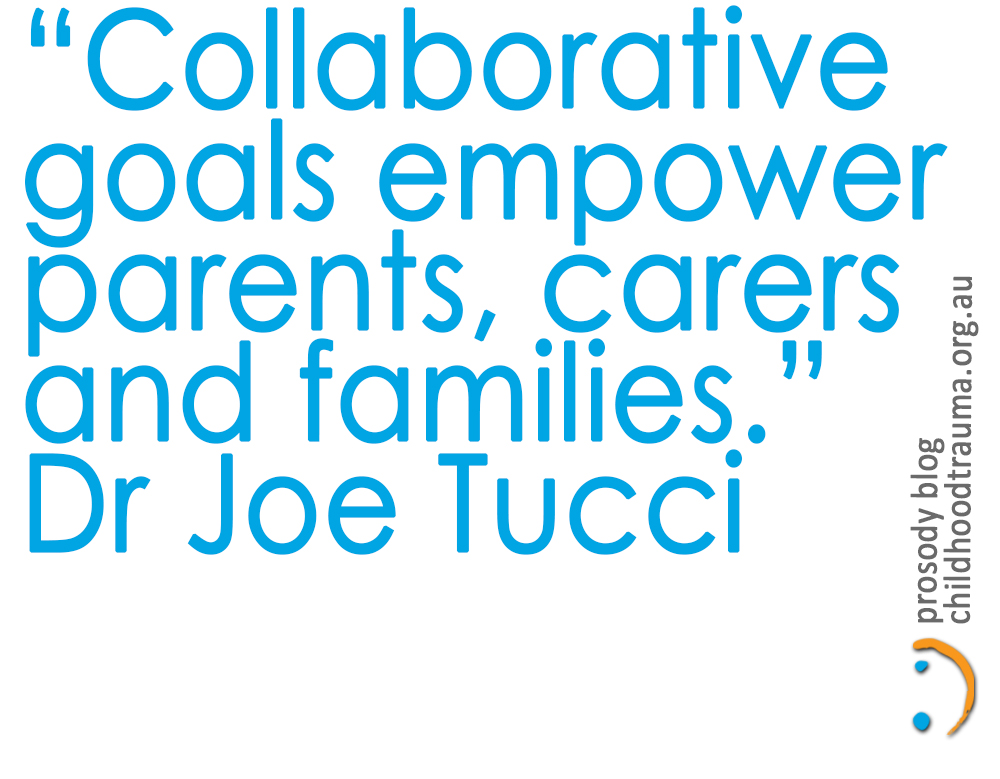
Trauma-Informed Goal Setting
This article was authored by Joe Tucci,
CEO at the Australian Childhood Foundation.
Goals are the statements that empower parents/carers, family and community into action. Goals express as concretely as possible what the situation will be like once the change has occurred. Each goal states what the outcome will be and how everyone will know when it is achieved.
The best kind of goals are those aimed at leading parents/carers and other family members towards positive and caring attitudes, emotions and behaviour towards their children that replace the abusive or neglecting behaviour, thinking and feelings. Doing more of what works will leave less opportunity for doing what does not work.
Effective goals, therefore, are not framed as “stopping abuse or neglect”, but rather “ensuring a child’s safety”.
This is an important consideration for contemporary practice. The way goals are constructed in language influences how possible they are to be adopted and really achieved by parents/carers and family. This language is not defined around the problem, but rather built around
- the strengths that parents/cares and families have in themselves, their relationships and their culture; and,
- the solutions they want to see happen so they can be more like what they want to be for themselves and their children.
Goals are pivotal then. They link the strengths of parents/carers and families to their own hopes and visions for their future. They help to interpret what to do to change with why that change is important to them and their children. Effective goals combine strategy and motivation.
Effective goals are therefore, by definition, set in collaboration with parents/carers and families. You need to help define the scope of what is needed to address the underlying issues, problems, and needs within families that have repeatedly led to the abuse and neglect of children. As a practitioner, you will have identified these in your assessment. You have also helped to find the dynamics and resources that have kept children safe in the family in the past. By collaborating in the goal setting, you can empower the parents, carers, and families.
 Collaborative goals empower parents/carers and families.
Collaborative goals empower parents/carers and families.
Effective goals should reflect a belief that people have the capacity to change and that change that results in affording children greater protection can be achieved.
It is critical to set goals which address the recovery needs of children and young people who have experienced trauma as a result of the abuse and neglect they have suffered.
Goals for children and young people will typically focus on the following three areas:
- Arousal regulation
- Relationships
- Adaptation
Arousal regulation in children and young people is an internal process that is supported by important adults through which their levels of distress and agitation are understood and responded to positively and carefully.
Arousal regulation goals include:
Increase children’s ability to tolerate stress in their environment;
Support children to find others who can help them calm down when they are distressed or agitated;
Build routines that are predictable for children as a way of reducing triggers that set off stress reactions; and,
Reduce the number of carers that look after children so they know who to expect at transitions during the week or day.
Relationships are the key to transformation in the lives of children and young people affected by trauma. Relationships offer attuned communication that can be contingent on the expressed needs of children and young people. In other words, positive people in children’s lives know the children from the inside out. They respond to changes in mood and levels of distress in children and young people. They know how to calm children down. They know how to motivate them. They know how to build opportunities for fun and play that is shared. They help children navigate difficult situations with others in their life that they are not certain about. Getting the relationships right and consistent in the lives of traumatised children and young people helps children reset their brain and body systems.
Relationship goals include:
- Increase the time that children and carers interact positively through structured and unstructured play activities;
- Build carers’ level of understanding of children’s moods over time;
- Improve the responses by parents/carers to children’s behaviour so that their underlying needs are met in a consistent way;
- Expand the time children and young people feel engaged with peers undertaking shared activities; and,
- Increase positive experiences for children and young people to feel secure in their connections to community and country.
Adaptation is the way in which children and young people move from the locked down internal brain and body systems to become more open to change and learning. Children and young people affected by trauma become more adaptive when their energies can be diverted from self protection and invested in trusting relationships with others. In these relationships, children and young people have a sense of security that enables them to try new things without feeling afraid and uncertain. At school and other environments, children start to learn and engage.
Goals that promote adaptation include:
Improve the consistency of the learning environment for children and young people at school;
Build a sense of belonging for children in environments that feel unfamiliar to them;
Increase the experience of success for children and young people in different environments; and,
Expand children and young people’s willingness to rehearse and practice tasks in order to promote their learning.
I would love to hear from some of you; would you share some of the goals you have developed with families about their children?
What do you think it is that has made some be more achievable than others?
